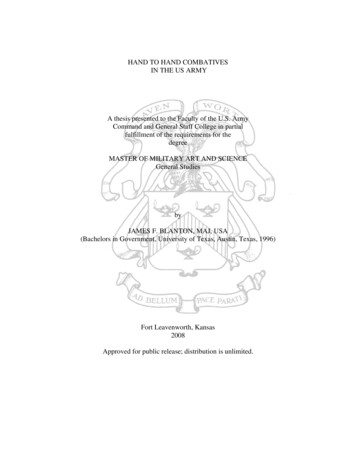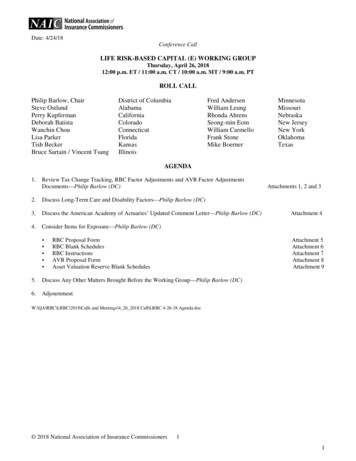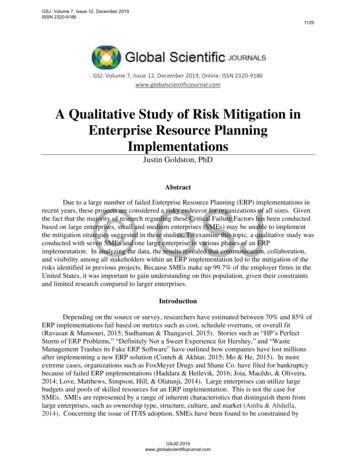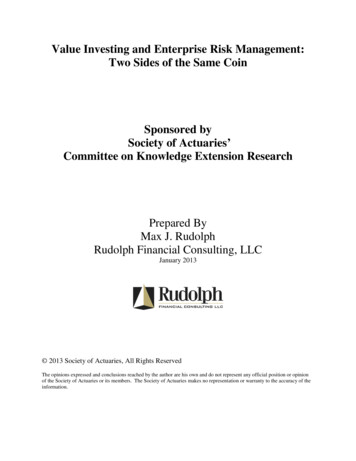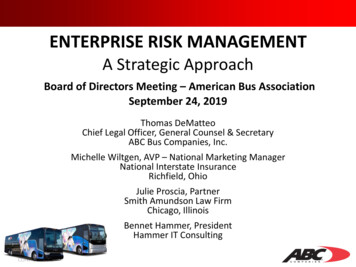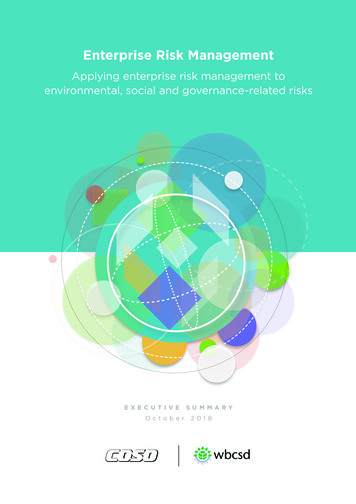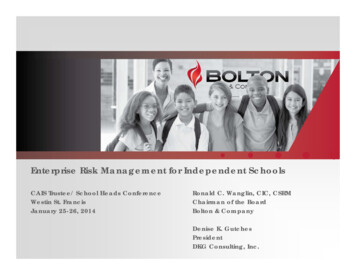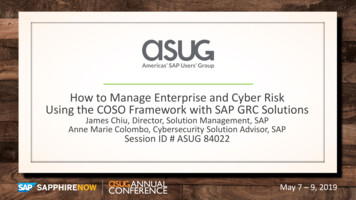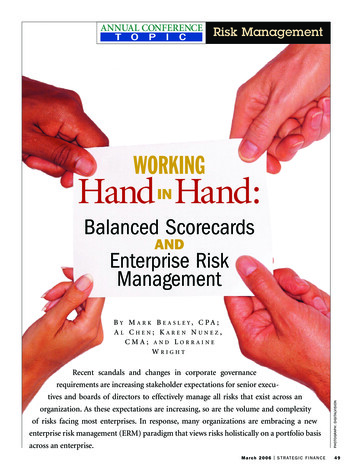
Transcription
ANNUAL CONFERENCET O P I CRisk ManagementWORKINGHand Hand:INBalanced ScorecardsANDEnterprise RiskManagementB Y M A R K B E A S L E Y, C PA ;AL CHEN; KAREN NUNEZ,CMA; AND LORRAINEWRIGHTRecent scandals and changes in corporate governancetives and boards of directors to effectively manage all risks that exist across anorganization. As these expectations are increasing, so are the volume and complexityof risks facing most enterprises. In response, many organizations are embracing a newenterprise risk management (ERM) paradigm that views risks holistically on a portfolio basisacross an enterprise.March 2006IS T R AT E G I C F I N A N C EPHOTOGRAPH: DIGITALVISIONrequirements are increasing stakeholder expectations for senior execu-49
Enterprise risk management differs from the more traditional approach, frequently described as the “silo” or“stovepipe” approach, where risks are often managed inisolation. An ERM approach seeks to strategically consider the interactive effects of various risk events with thegoal of balancing an enterprise’s entire portfolio of risksto be within the stakeholders’ appetite or tolerance forrisk. ERM takes an enterprise-wide focus by strategicallylooking at risks in a coordinated, consistent manner. Theultimate goal is to ensure that the value of the enterpriseis preserved and even enhanced.Executives first learning about ERM often share an initial concern that it requires implementation of a separatenew system or infrastructure, but most ERM adoptersargue that infrastructures already in place can often beleveraged efficiently. For example, the balanced scorecard,a widely known strategic performance measurement system, can be leveraged to support an ERM view of riskmanagement. With an emphasis on continuous improvement, the balanced scorecard is the most commonstrategy-based performance management system in placetoday and is widely used to link an organization’s missionand strategy to performance measures and strategicallyaligned initiatives. Because it takes an enterprise-wideapproach, it provides an excellent platform that can easilybe enhanced to focus on risk management as part of performance measurement evaluations.Balanced scorecards measure an organization’sprogress toward achieving strategic goals, while ERMhelps company leaders think through positive and negative factors that can affect the achievement of their goals.The combination strengthens the likelihood of achievingstrategic objectives. Thus, the two go hand in hand.ON ONE HAND: ERMThe ERM approach to risk management began to emergein the late 1990s. Early adopters recognized that changesin technology, globalization, corporate financing, andnumerous other risk drivers were increasing the complexity and volume of risks. They also began to realize thattraditional approaches were no longer effective ways toidentify, assess, and respond to the growing array of risksacross a complex enterprise.Now ERM has become a hot topic, representing morethan just another management fad. In fact, as PatrickStroh wrote in the July 2005 Strategic Finance article“Enterprise Risk Management at UnitedHealth Group”:“ERM is quickly becoming the new minimum standard,and it may well be the key to survival for many compa50S T R AT E G I C F I N A N C EIMarch 2006nies.” It offers significant opportunity for competitiveadvantage, providing value well beyond mere compliancewith regulatory expectations.This shift in risk management trends led the Committee of Sponsoring Organizations of the TreadwayCommission (COSO) to develop a conceptual framework for enterprise risk management. Enterprise RiskManagement—Integrated Framework, released inSeptember 2004, defines enterprise risk managementas follows:Enterprise risk management is a process, effected byan entity’s board of directors, management, and otherpersonnel, applied in strategy setting and across theenterprise, designed to identify potential events thatmay affect the entity, and manage risk to be within itsrisk appetite, to provide reasonable assurance regarding the achievement of entity objectives.A core element of ERM is that risks and strategy arealigned. As management examines various strategic alternatives, it also evaluates them to determine the impact onthe enterprise’s total risk profile. Once strategy choicesare made, management identifies risk responses, assignsaccountabilities, and monitors implementations in acoordinated and integrated approach to ensure the objectives are met. Thus, ERM is integral to strategic planningand performance assessment.ON THE OTHER: BALANCED SCORECARDSA generic balanced scorecard translates an organization’soverall mission and strategy into specific, measurableoperational and performance metrics across fourperspectives: Learning and Growth for Employees, Internal Business Processes, Customer Satisfaction, and Financial Performance.These four perspectives are designed to be integratedto achieve the enterprise’s vision and strategy. Learningand growth objectives are designed to enhance employeecompetencies and strategic awareness so that internalbusiness processes are consistent with desired objectives.Better performance of internal business processes shouldlead to greater customer satisfaction, which then leads toimproved financial performance, enabling the achievement of an entity’s goals and objectives based on financial performance (see Figure 1).A balanced scorecard provides an integrated, comprehensive performance measurement tool that reflects mea-
Figure 1:mately achieved.General Framework of the Balanced ScorecardHolistic Perspective. Theyapproach strategy at the enterprisewide level by viewing performancemeasurement and risks, respectively, on a holistic basis across theenterprise.GOALSTo achieve our vision,how will we sustain ourability to change andimprove?MEASURESLearning & Growth PerspectiveInternal Business PerspectiveTo satisfy our stakeholdersand customers, wheremust we excel in ourbusiness processes?GOALSTo succed financially, howshould we appear to ourshareholders?MEASURESFinancial Perspectivesures deemed critical to the success of a company’s strategy. In essence, it “balances” both financial and nonfinancialobjectives in an integrated manner, ultimately increasingthe likelihood that overall strategic objectives are achieved.The balanced scorecard helps tie individual responsibilities to the enterprise’s strategy by defining specificstrategic responses across multiple perspectives and monitoring the implementation of those responses throughfinancial and nonfinancial performance measures. Moreover, integrating performance measures across the fourperspectives reinforces the importance of achievingobjectives at each level.Linking these performance measures helps individualsperform in a manner that supports the enterprise’s overall strategy since their performance is measured againstspecific objectives. Thus, balanced scorecards aredesigned to take a holistic view of the enterprise acrossmultiple perspectives, capturing information about performance to ensure that individuals implement responsesconsistent with the overall strategic mission.COMMON GROUNDERM and balanced scorecard systems share many elements. As a result, a balanced scorecard system that isalready implemented may provide a unique platform foran enterprise to leverage an existing infrastructure to reapthe benefits of ERM.Here’s a look at some of the common elements of balanced scorecards and ERM:Focus on Strategy. Both ERM and balanced scorecardsare linked to strategy with the objective of increasing thelikelihood that the enterprise’s overall strategy is ulti-Emphasis on Interrelationships.They emphasize an integratedstrategic approach.Top-Down Emphasis. For both towork effectively, they must be driven from the top of the organization. Without an effective “tone atthe top,” they may fail.Desire for Consistency. Bothpursue a balanced and consistentapproach across multiple dimensions of an enterprisethat are managed by numerous individuals with differentresponsibilities and experiences.Focus on Accountabilities. Both focus on individualaccountability.Continuous Nature. Both are designed to be ongoing,continuous processes. Balanced scorecards pursue continuous improvement, and ERM constantly evaluates andmonitors new risks.MEASURESVISION ANDSTRATEGYGOALSMEASURESTo achieve our vision, howshould we appear to ourcustomers?GOALSCustomer PerspectiveMAKING IT WORKLet’s take a look at how to cost effectively leverage anexisting balanced scorecard system to provide a framework for managing risk holistically across an enterprise,facilitating an ERM approach to risk management.Most balanced scorecard systems translate the organization’s overall mission and strategy into operationalobjectives and performance metrics across the four perspectives. Specific goals and related performance measurements are identified for each perspective. We usesupply chain management as an example.Supply chain management plays an important role inthe managerial framework of most companies because itgenerally encompasses activities associated with the flowof materials and information from raw materials to theend user (customer). Companies manage their supplychains in numerous ways, including outsourcing, barebones inventory levels (Just-in-Time systems), andsophisticated information system networks. A disruptionanywhere along the supply chain can have a direct effecton a company’s ability to continue operations and supplyproducts/services to the market.March 2006IS T R AT E G I C F I N A N C E51
Increasing globalization and lengthy supply chainsescalate risk. Disruptions can arise from numerous internal and external sources, such as natural disasters, labordisputes, supplier bankruptcy, IT system breakdowns,capacity problems, and terrorism. Poorly managed disruptions can interrupt or delay material, information,and cash flow, leading to significant risks.Balanced scorecards are often used to manage an organization as a connected enterprise, and many peopleargue that they are perfectly suited for supply chain management since a supply chain can extend from suppliers’suppliers to customers’ customers. That, combined withthe nature and extent of risks that can affect an enterprisethrough its supply chain, increases the significance ofillustrating how balanced scorecards can be leveraged intoERM. For example, in Figure 2 under Learning andGrowth, goals and performance measurements related tosupply chain management emphasize learning andgrowth objectives for employees, such as “to increaseemployee identification of potential supply chain disruptions” and “comparisons of actual disruptions.”The enterprise goals for individuals relate to increasingproduct and process innovation and improving information flows among employees and external parties. Theperformance of individuals within the organization ismeasured using the metrics identified in the Measuressection. Similar goals and measures are created for theInternal Business Processes, Customer Satisfaction, andFinancial Performance perspectives. As these goals areachieved, the benefits flow through to the customers, whoultimately increase the financial success of the enterprise.An enterprise can easily include additional risk management aspects in both the goals and measurement components of the balanced scorecard. The scorecard can beenhanced by including goals and objectives for risk management and by capturing performance-based risk metrics.In Figure 3, explicitly focused risk objectives andaccountabilities can be incorporated into the balancedscorecard performance measurement system, which thenintegrates risk management with performance measurement. The example includes Enterprise Risk ManagementComponents in each box representing the four balancedscorecard perspectives.The Enterprise Risk Management Components sectionin each box includes three risk-focused goals and threerisk-related performance measures. These could beincluded in the balanced scorecard to create performanceincentives for effective enterprise risk management. Hereare some examples.52S T R AT E G I C F I N A N C EIMarch 2006Learning and Growth for Employees. A challenge forany risk management system is ensuring that all employees embrace a common set of definitions and perspectives. Depending on an employee’s background ortraining, the concepts of “risk” and “risk management”may vary, so one core objective of ERM is to bring a consistent and clearly defined approach to risk managementto all employees. As a result, training objectives and performance measures related to learning and educationabout risk management can be added to this perspectiveof the balanced scorecard.Individual Business Processes. While risks can arisefrom external forces, they also arise from internal businessprocesses, such as supply chain processes. Thus, ERMrequires that individuals throughout an organizationidentify, assess, respond to, and monitor risks throughoutall business processes, not just financial ones. As a result,risk objectives and measurement are easily linked. Goalsrelated to acceptable ranges or variations of risks within abusiness process and related risk performance metrics caneasily be integrated into this perspective.Customer Satisfaction. The balanced scorecard system isdesigned to help individuals within the organization focuson customer satisfaction, which in turn should improvefinancial performance. Many organizations focus on keyoperational risks, but they often ignore or fail to adequatelyconsider risks related to strategy, markets, and reputation,all of which may affect or be affected by customer satisfaction. The customer satisfaction perspective provides an easylink to the management of risks related to strategy, market,and reputation. Risk goals related to customers, markets,and reputation fit naturally into this component.Financial Performance. The possible responses to asingle risk can include varying costs and benefits. Anyrisk management system has to consider the costs ofresponding to risks relative to its benefits. Thus, thecost/benefit analysis of risk management is critical to successful ERM. The financial performance perspective ofthe balanced scorecard provides the natural connectionfor ERM cost/benefit analysis of responses.HAND IN HANDLeveraging balanced scorecards into ERM actuallystrengthens the scope of management’s focus on broadersets of risks. Many ERM practices today have focused onSarbanes-Oxley compliance, with fewer focusing onstrategic, market, and reputation risks. Leveraging balanced scorecards into ERM will broaden the scope byexplicitly linking risk management to strategic perfor-
Figure 2:Example of a Balanced Scorecard Framework for Supply Chain ManagementLEARNING AND GROWTH FOR EMPLOYEESTo achieve our vision, how will we sustain our ability to change and improve?GOALS:MEASURES: To increase employee “ownership” ofthe supply chain process Employee survey scores about ownership andresponsibility for assigned supply chain processes To improve information flowsacross stages of the supply chain Changes in information reports and frequency ofreports across partners in the supply chain To increase employee identification ofadvanced potential supply chain disruptions Comparisons of actual disruptions to extent of advancedreports about drivers of potential disruptionsINTERNAL BUSINESS PROCESSESTo satisfy our stakeholders and customers, where must we excel in our business processes?GOALS:MEASURES: To reduce waste generated across the supply chain Pounds of product/scrap sent for disposal To shorten the time from start to finishacross the supply chain Length of time from purchase of raw material todelivery of product/service to customer To achieve unit cost reductions Unit costs per product/service delivered and percentage of supply chain target costs achievedCUSTOMER SATISFACTIONTo achieve our vision, how should we appear to our customers?GOALS:MEASURES: To improve product/service quality Number of customer contact points in the supply chain To improve timeliness of product/servicedelivery Length of time from customer order to customerdelivery To improve customer perception of value Customer scores about product/service valueFINANCIAL PERFORMANCETo succeed financially, how should we appear to our shareholders?GOALS:MEASURES: To obtain higher profit margins Profit margin by supply chain partner To improve cash flows Net cash generated through the supply chain To generate revenue growth Increase in number of customers and sales percustomer Percentage annual return on supply chain assetsmance measurement.The integration of ERM also strengthens the balancedscorecard process. As the balanced scorecard capturesmore information about risk management objectives andperformance measures, people become more aware ofrisks and the need for managing those risks, so learningand growth are enhanced.A stronger perspective about risk management issuesshould ultimately lead to improved internal businessprocesses by eliminating or reducing risk exposures within key business processes. That, in turn, should improvecustomer satisfaction and financial performance. Thus, inthe end, while balanced scorecards can be used to benefitERM, the integration can allow ERM to bolster balancedscorecard effectiveness, too.As businesses evolve, the profile of risks will continueto grow in complexity and volume. Business leaders mustadopt an effective tool for managing the portfolio of risksMarch 2006IS T R AT E G I C F I N A N C E53
Figure 3:Example of an Integrated Balanced Scorecard and ERM Frameworkfor Supply Chain ManagementLEARNING AND GROWTH FOR EMPLOYEESTo achieve our vision, how will we sustain our ability to change and improve?GOALS:MEASURES: To increase employee “ownership” ofthe supply chain process Employee survey scores related to ownership andresponsibility for assigned supply chain processes To improve information flows across stagesof the supply chain Changes in information reports and frequency of reportsacross partners in the supply chain To increase employee identification ofpotential supply chain disruptions Comparisons of actual disruptions to extent of advancedreports about drivers of potential disruptionsEnterprise Risk Management ComponentsRISK-RELATED GOALS:RISK-RELATED MEASURES: To increase employee awareness ofsupply chain risks Number of employees attending risk managementtraining To increase supplier accountabilities fordisruptions in the supply chain Provisions in contracts with suppliers addressing riskmanagement accountabilities and penalties To increase employee awareness ofintegration of supply chain risks withother risks facing enterprise Number of departments participating in supply chainrisk identification and assessment workshopsINTERNAL BUSINESS PROCESSESTo satisfy our stakeholders and customers, where must we excel in our business processes?GOALS:MEASURES: To reduce waste generated across the supply chain Pounds of product/scrap sent for disposal To shorten the time from start to finishacross the supply chain Length of time from purchase of raw material todelivery of product/service to customer To achieve unit cost reductions Unit costs per product/service delivered andpercentage of supply chain target costs achievedEnterprise Risk Management ComponentsRISK-RELATED GOALS:RISK-RELATED MEASURES: To reduce high probability and impactthreats to supply chain processes Number of employees attending risk managementtraining To identify specific tolerances for riskfor key supply chain processes Number of process variances that exceed specifiedacceptable risk tolerance ranges To reduce number of exchanges of supplychain risks to other enterprise processes Extent of risks realized in other functions of enterprisefrom risk drivers traced to supply chain processesto meet growing stakeholder expectations for effectiverisk
Enterprise Risk Management—Integrated Framework, released in September 2004, defines enterprise risk management as follows: Enterprise risk management is a process, effected by an entity’s board of directors, management, and other personnel, applied in strategy setting and across the enterp

